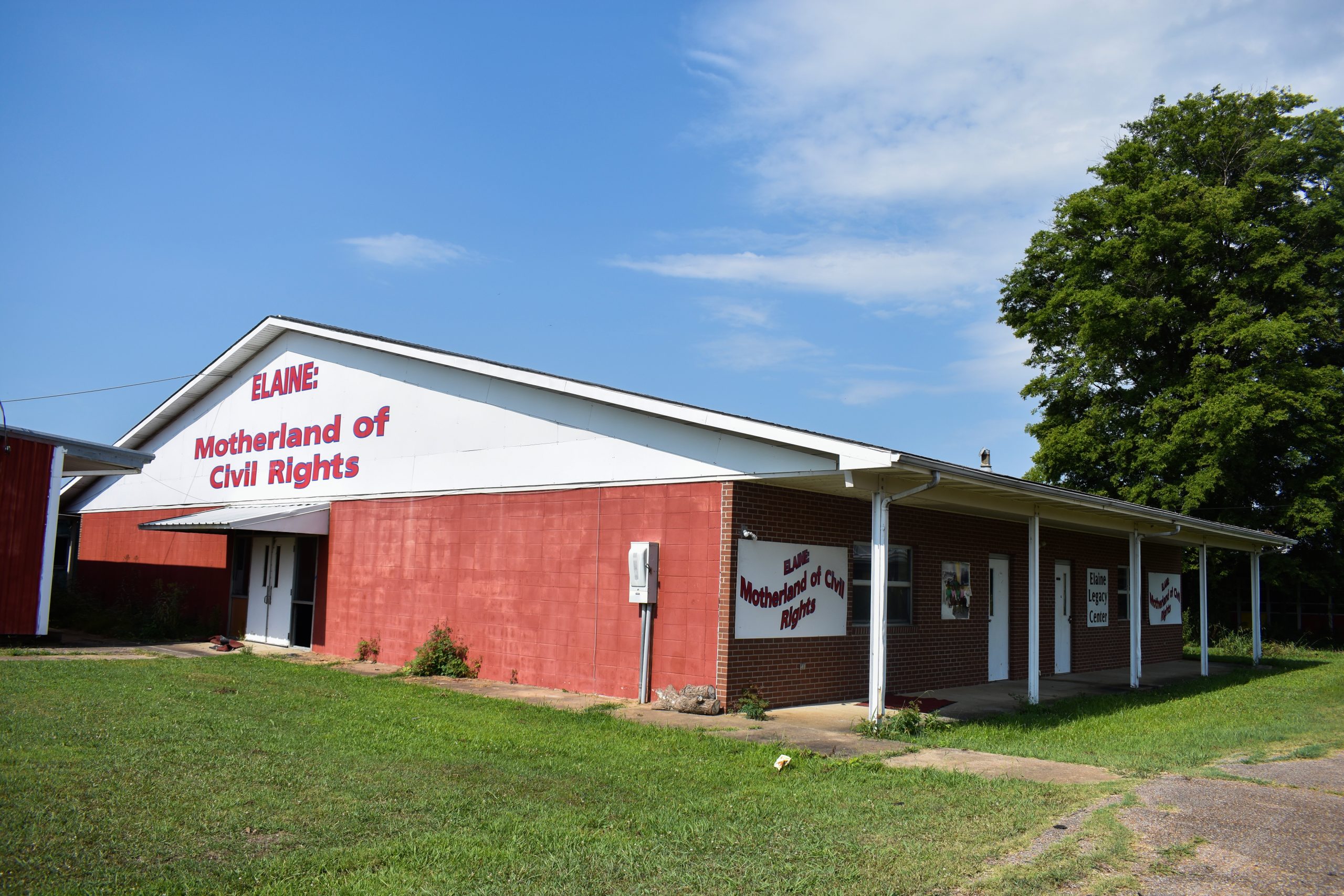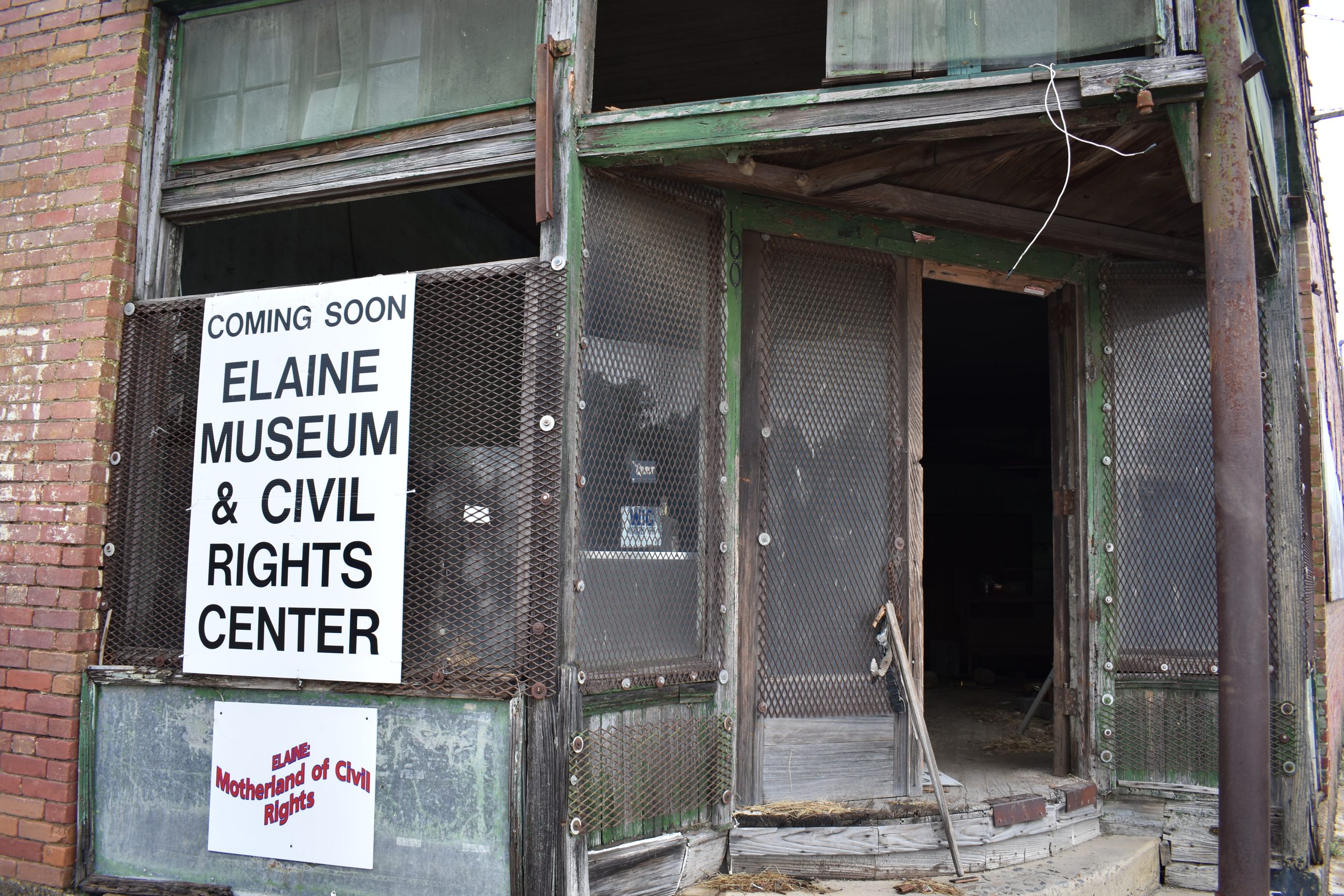Two narratives: How a 1919 massacre tore Elaine, Ark., apart
Segregation, poverty and differing accounts from the Black and white press
By Kelly Livingston and Madison Peek
ELAINE, Ark. — On a late September night in 1919, about 100 Black farmers seeking fairer prices for their crops gathered for a union meeting at a church a few miles north of this tiny farm town.
When white leaders heard, they reacted with violence. Newspapers reported that white mobs, over four days, chased Black men, women and children, slaughtering them in Elaine and across the green farms and swamps of Phillips County.
All the Black farmers wanted were fair prices, but “that’s like the revolution has occurred because that threatens to shift the entire power structure of the South in the favor of Black farmers,” said Dr. Paul Ortiz, a history professor and director of the University of Florida’s Samuel Proctor Oral History Program.
This work is a collaboration of the Howard Center for Investigative Journalism and Capital News Service at the University of Maryland, Morgan State University, Hampton University, Howard University, Morehouse College, North Carolina Agricultural & Technical State University and the University of Arkansas.
Historians say the massacre claimed five white lives and more than 200 Black lives, though the true number of Black deaths is unknown and some estimates put it much higher.
But that’s not what the readers of white newspapers, including the Arkansas Democrat, the Arkansas Gazette and the Helena World, would have read in the days during and after the massacre.
White newspapers filled their front pages with sensational headlines about a Black uprising, ignoring the economic inequality at the core of the conflict.
As the U.S. has reckoned with its racist past, the 1919 Elaine Massacre — one of the deadliest acts of violence against Black people in American history — has drawn new attention, especially in the years surrounding its 100th anniversary. That year, hundreds of Black people were killed in at least 25 cities across the country, a violent siege today called “Red Summer.”
The cover-up orchestrated by Elaine’s wealthy white landowners and the government, aided by the white-centric reporting of white-owned newspapers, led to a scarcity of information about the massacre.
More than 100 years later, Black descendants say the massacre still affects their lives and contributes to the area’s economic struggles.
Few Black voices
Two narratives emerged from the chaos of the massacre: the white press’ version based on the story of white leadership, and the Black press’ reports based on the accounts of Black victims.
Headlines such as “VICIOUS BLACKS WERE PLANNING GREAT UPRISING” and “NEGROES HAVE BEEN AROUSED BY PROPAGANDA” were atop the front pages of the Arkansas Gazette on Oct. 3, 1919, and Oct. 4, 1919, respectively.
“NEGROES HAD PLOT TO RISE AGAINST WHITES, CHARGED,” read the front page of the Arkansas Democrat on the third day of the massacre.
Missing from both of the Little Rock white newspapers’ reports were the perspectives of Black victims, which were reported by the Black press and have been passed down through generations.
“My grandmama stood up there on the railroad track — Amanda Davis stood up on a railroad track and watched them hauling bodies in trucks,” said the Rev. Anthony Davis, whose grandparents lived through the massacre.
“It was a bunch of trucks — hauling bodies stacked up like logs,” Davis said. “They had bodies laying all around the field.”
PRINTING HATE
EXPLORE ALL STORIES
To correct the historical white narrative, researchers are trying to capture these stories from descendants of the massacre. For the past few years, faculty and students from the University of Florida have been recording oral histories in Elaine.
“We trusted ‘archival record and the written record,’ but that record was often created by people who either perpetrated the massacre or covered it up,” Ortiz said.
Adrienne Jones, an archivist at the University of Arkansas at Little Rock, agrees.
“The white press did what has happened in other situations in history. There’s an event happening between a Black population and a white population, and guilt is automatically assumed to be put on the Black population,” Jones said.
“This trope of ‘Blacks are rising up to kill their white neighbors’ comes up with a white press,” she said. “There are more white publications and they do interact with one another across state lines. This kind of echo happens.”
The story of the violence was spread by the local white press and sent around the country by The Associated Press, working its way to newspapers from The New York Times to The Los Angeles Times.
In a news report on Oct. 3, 1919, the Democrat wrote: “The Phillips County trouble, it should be said, is not a race riot in the strict sense of the word. It is rather a negro uprising nipped in the bud by prompt and vigorous action which does credit to Phillips County, both for its efficiency and notable self-restraint.”

Dramatic Scenes
Newspapers are often called the first draft of history, and the white Arkansas press painted a dramatic tale — front pages throughout the days of conflict were littered with descriptions of fighting between Black and whites, instead of depictions of a massacre.
The Democrat reported that a group of Black townspeople “armed with high-powered rifles” ambushed a group of officers and attempted to kill them. The Gazette described a “battle” between soldiers tromping through marshlands, looking for “negro insurrectionists” in hiding. The Helena World described two Black men walking in the street until they were shot down by officers and residents, which led to “no more trouble.”
The newspapers often quoted only white community members, from Gov. Charles Hillman Brough to white citizens calling about the violence.
White newspapers also heavily relied on the accounts of the Arkansas National Guard troops, who came to Elaine by the hundreds at the request of the governor. Some historians say the soldiers increased the death toll, aiding white posses in the slaughter of Black families.
The loss of life was treated inequitably by newspapers, which consistently reported the names and funeral announcements of white people killed in the violence.
The first coverage of the massacre in the Helena World, a local paper, was a front-page lead story that memorialized a local white real-estate dealer, who in the previous issue bought an ad in the paper.
On Oct. 2, 1919, an Associated Press story published by the Democrat said the number of Black victims was unknown but there were “plenty of them.” The next day, an AP story in the Democrat reported at least 14 Black people died.
Easter McClain, who was raised in Elaine, said her great-uncle told the family, “They killed so many Black people that the blood ran through the streets like water.”
‘Robbery of tenant farmers’
In the days after the massacre, NAACP field secretary Walter White headed to Elaine to investigate, finding a much different story from the one spreading across the country.
The Chicago Defender, a prominent Black newspaper, published White’s findings on the front page on Nov. 1 in an article titled “Expose Arkansas Peonage System; Truth Comes to Light When Unprejudiced Report Is Given.”
“The cause of the disturbances in Arkansas was systematic robbery of tenant farmers and share croppers,” White wrote. “Many white people expressed doubts of the truth of the ‘massacre’ stories sent out. It appears that the purpose of those stories was to cloak the robbery of tenant farmers by white landlords and agents.”
White’s account was carried throughout the country by the Black press.
Brough, along with the white newspapers, accused the Black press of inciting the violence by riling up their Southern Black readers. Brough even went so far as to try to restrict the distribution of northern Black newspapers in the area, Jones said.
“The accounts of every reporter agreed that the trouble was an organized and premeditated insurrection and not a sporadic race riot,” the Arkansas Gazette wrote on Nov. 14, 1919. “Many newspapers in the North editorially pooh-poohed the idea of insurrection and published a statement from a Northern organization, organized ostensibly to aid the negro in the South.”
In Baltimore, The Afro-American published a letter from an NAACP-backed correspondent who was “near the scene of the race riots in Arkansas.” The article alleged that the white press was printing propaganda to obscure the economic inequality Black farmers faced.
“The real issue was a dispute over the price of cotton between the tenants and planters,” the correspondent wrote. “The propaganda published in the press about ‘Negroes being armed to kill all white people and take their farms away from them’ is too ridiculous to give any thought.”

Despite the work of the Black press, white newspapers continued to perpetuate their false story. After hundreds of Black people were massacred, no white people were tried in their deaths.
Black people were rounded up, jailed in Helena and tortured until they confessed a role in the deaths of the five white people — part of a legal cover-up concocted by a committee of wealthy white farmers and businessmen appointed by the governor.
In the end, estimates range between 65-75 Black men were sentenced to long-term prison sentences and 12 were sentenced to death. A years-long legal battle fought by the NAACP resulted in two cases, one of which went all the way to the U.S. Supreme Court (Moore v. Dempsey) while the other went to the Arkansas Supreme Court. The high courts agreed that the men’s due-process rights had been violated, and none of the 12 were executed.
‘Echoes down through the generations’
The impact of the massacre and subsequent trials is still felt in the Elaine community. Many Black families fearing repercussions would not tell their stories for generations.
Lisa Hicks-Gilbert, 53, founder of Descendants of the Elaine Massacre of 1919, said she was born and raised in Elaine but learned about the massacre in 2008.
“Even when I confirmed that it happened with my grandmother, I had to promise I wouldn’t talk about it ‘until after she done left this earth,’” Hicks-Gilbert said. “She was afraid … afraid somebody would do something to her boys.”
Descendants say Elaine — now a town of around 659 in eastern Arkansas — never recovered from the violence.
“The trauma of these events echoes down through the generations,” Ortiz said.
The differing accounts of the massacre, economic struggles and racism that were apparent 102 years ago continue to affect the community today.
James White, 59, director of the Elaine Legacy Center, said, “There’s no jobs here. There’s no way that Black people can make a living on the land they once owned or their ancestors once owned.”
The Howard Center was unable to verify historic land ownership in Phillips County.
Today, the small town’s Main Street is haunted by empty stores and shells of buildings. An aging storefront lined with wizened Santas and a scattering of reindeer promise the town’s annual Christmas extravaganza, while across the street a dusty assortment of birdhouses are crammed in a window display.
Elaine’s median household income is $26,250, according to the 2019 census data. White households in Elaine and the surrounding area earn about the same as the Arkansas median of $47,597. But the median for Black households is about half that.
The national median is $62,843.
“This is a segregated town where you got the white people on the south side, you got Black people on the north side,” White said. “It’s still a divided town.”
Laura Snowden, who works at the one restaurant on Main Street, Delta Grill, agreed Elaine is segregated, but said that’s because people stay on their own side of town. Snowden, 35, who is white, said she thinks people talking about the massacre again has created tension.
“I don’t like it, but they say it’s for the history,” she said. “But, I don’t know. I feel like they’re trying to start something.”
Some descendants say the national news outlets that have recently come to cover the story of the massacre have not gotten the story right, just as they failed to do in 1919.
“Some journalists just come in here for a day or two and they gone. They run up to that courthouse and get a little information that they got up there and they gone,” White said. “They still will twist it every time.”
The current owners of The Arkansas Democrat-Gazette acknowledge the mistakes of the past.
The Democrat was purchased in 1974 by the Palmer Group, headed by Walter E. Hussman. His son, Walter E. Hussman Jr., became the publisher. After years of fierce competition, the Democrat bought the Arkansas Gazette in 1991 after it was closed by Gannett and renamed the combined paper The Arkansas Democrat-Gazette.
Eliza Gaines, who is in the fourth generation of the Hussman newspaper family, is the managing editor of the Democrat-Gazette. In an email response to the Howard Center, Gaines said, “The original articles about the Elaine Massacre were grossly inaccurate and misleading. The events were reported solely from the standpoint of white officials.”
Walter Hussman Jr., who came into the public eye in June over a tenure dispute for Black journalist Nikole Hannah-Jones at the University of North Carolina at Chapel Hill, said in an email that the Democrat-Gazette’s staff today is led by the company’s core values of impartiality and credibility.
“The pursuit of truth is a noble goal of journalism. But the truth is not always apparent or known immediately,” Hussman wrote. “Journalists’ role is therefore not to determine what they believe at that time to be the truth and reveal only that to their readers, but rather to report as completely and impartially as possible all verifiable facts so that readers can, based on their own knowledge and experience, determine what they believe to be the truth.”
The Democrat-Gazette has covered the memorialization of the Elaine Massacre, particularly around its centennial, and published an opinion column discussing how the papers published misinformation. But there was no apology from the editorial board, no discussion of how the misinformation impacts the community today and no reflection on the paper’s current progress.

In the nearby town of Helena, some residents complain that the Helena World covers the most controversial, negative stories, marking a pattern spanning more than 100 years.
However, Helena World co-owner and publisher Andrew Bagley, who bought the paper in 2019, said it has limited reporting resources, with a staff of two full-time employees, one part-time employee, two freelance reporters, Bagley and his co-owner.
Bagley acknowledged that the paper tried to minimize the impact of the massacre at the time, but said he has not fully researched the paper’s coverage of the massacre nor plans to issue an apology, since they only recently acquired the paper.
Today, the Helena World is trying to bolster its coverage of the community and the county, including Elaine, Bagley said. It covered a Black Lives Matter protest last summer in Helena, assigned a freelance Elaine reporter and wrote about the memorial of the massacre built on its centennial.
Bagley said these steps to expand their coverage are considerable for a community that previously wouldn’t acknowledge the massacre publicly.
Several other newspapers across the country, including the Montgomery Advertiser, the Orlando Sentinel and The Capital newspaper in Annapolis, Maryland, have issued apologies for problematic past coverage surrounding lynchings.
Despite efforts to acknowledge the massacre, Dr. Kyle Miller, director of the Delta Cultural Center and a descendant of massacre victims, said the community still has to reckon with its effects.
“Everything that we see, from the decay of the town to population decline and all of these things, the racial tensions,” he said, “I think a lot of that stuff bred from Elaine.”


